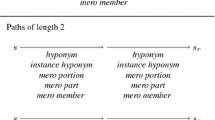Abstract
We give a brief outline of the design and contents of the English lexical database WordNet, which serves as a model for similarly conceived wordnets in several European languages. WordNet is a semantic network, in which the meanings of nouns, verbs, adjectives, and adverbs are represented in terms of their links to other (groups of) words via conceptual-semantic and lexical relations. Each part of speech is treated differently reflecting different semantic properties. We briefly discuss polysemy in WordNet, and focus on the case of meaning extensions in the verb lexicon. Finally, we outline the potential uses of WordNet not only for applications in natural language processing, but also for research in stylistic analyses in conjunction with a semantic concordance.
Similar content being viewed by others
References
Apresjan, Y. “Regular Polysemy”. Linguistics, 142 (1973), 5–32.
Chaffin, R., D. J. Hermann and M. Winston. “An Empirical Taxonomy of Part-whole Relations: Effects of Part-whole Relation Type on Relation Identification”. Language and Cognitive Processes, 3 (1988), 17–48.
Fellbaum, C. “Adverbs in Agentless Actives and Passives”. In Proceedings of the 21st Meeting of the Chicago Linguistic Society, Parasession on Agentivity and Causatives. Eds. W. Eilfort et al., Chicago, IL: University of Chicago, 1985a.
Fellbaum, C. On the Middle Construction in English. Bloomington, IN: Indiana University Linguistics Club, 1985b.
Fellbaum, C. (ed.). WordNet: An Electronic Lexical Database. Cambridge, MA: MIT Press, 1998a.
Fellbaum. C. “A Semantic Network of English Verbs”. In WordNet: An Electronic Lexical Database. Ed. C. Fellbaum, 1998a.
Fellbaum, C. “The English Verb Lexicon as a Semantic Net”. International Journal of Lexicography, 3 (1990), 278–301.
Fellbaum, C. “Semantics via Conceptual and Lexical Relations”. In Breadth and Depth of the Lexicon. Ed. E. Viegas, Dordrecht: Kluwer, in press.
Gross, D., U. Fischer and K. J. Miller. “The Organization of Adjectival Meanings”. Journal of Memory and Language, 28 (1989), 92–106.
Justeson, J. and S. Katz. “Co-occurrences of Antonymous Adjectives and Their Contexts”. Computational Linguistics, 17 (1991), 1–19.
Keyser, S. J. and T. Roeper. “On the Middle and Ergative Constructions in English”. Linguistic Inquiry, 15 (1984), 381–416.
Landes, S., C. Leacock and R. Tengi. “Building Semantic Concordances”. In WordNet: An Electronic Lexical Database. Ed. C. Fellbaum, 1998.
Leacock, C., M. Chodorow and G. A. Miller. “Using Corpus Statistics and WordNet Relations for Sense Identification”. Computational Linguistics, 24 (1998), 1.
Levin, B. English Verb Classes and Alternations. Chicago, IL: University of Chicago Press, 1993.
Miller, G. A. “Dictionaries in the Mind”. Language and Cognitive Processes, 1 (1986), 171–185.
Miller, G. A. “Nouns in WordNet”. International Journal of Lexicography, 3 (1990), 235–264.
Miller, G. A., M. Chodorow, S. Landes, C. Leacock and R. G. Thomas. “Using a Semantic Concordance for Sense Identification”. In Proceedings of the ARPA Workshop on Human Language Technology. San Francisco: Morgan Kaufman, 1994.
Miller, G. A. “Preface”. WordNet: An Electronic Lexical Database. Ed. C. Fellbaum, 1998a.
Miller, G. A. “Nouns in WordNet”. WordNet: An Electronic Lexical Database. Ed. C. Fellbaum, 1998b.
Miller, G. A., C. Leacock, R. Tengi and R. T. Bunker. “A Semantic Concordance”. In Proceedings of the ARPA Workshop on Human Language Technology. San Francisco: Morgan Kaufman, 1993.
Miller, K. “Modifiers in WordNet”. WordNet: An Electronic Lexical Database. Ed. C. Fellbaum, 1998.
Nunberg, G. The Pragmatics of Reference. Bloomington, IN: Indiana University Linguistics Club, 1978.
Ostler, N. and B. T. S. Atkins. “Predictable Meaning Shifts: Some Linguistic Properties of Lexical Implication Rules”. In Lexical Semantics and Knowledge Representation. Eds. J. Pustejovsky and S. Association for Computational Linguistics, 1992, pp. 76–87.
Perlmutter, D. M. “Impersonal Passives and the Unaccusative Hypothesis”. Berkeley Linguistics Society, 4 (1970), 157–189.
Weinreich, U. Explorations in Semantic Theory. Den Hague: Mouton, 1972.
Author information
Authors and Affiliations
Rights and permissions
About this article
Cite this article
Fellbaum, C. A Semantic Network of English: The Mother of All WordNets. Computers and the Humanities 32, 209–220 (1998). https://doi.org/10.1023/A:1001181927857
Issue Date:
DOI: https://doi.org/10.1023/A:1001181927857




